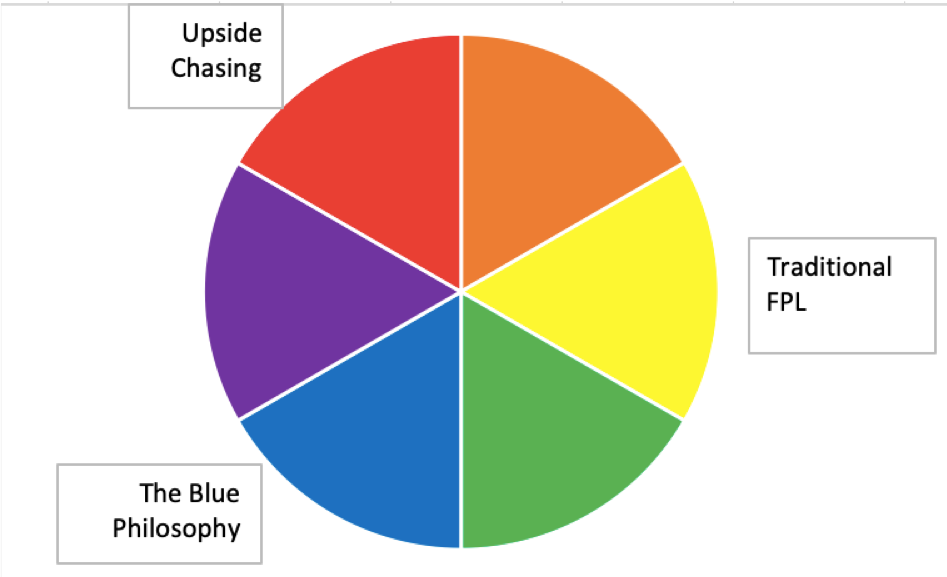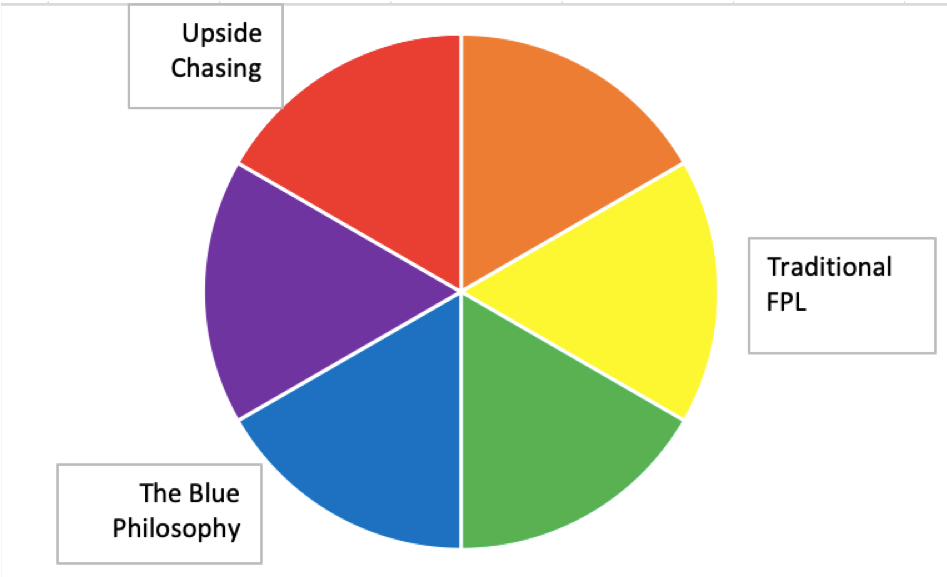The traditional way to play FPL has often been taken for granted. So much so that, in a podcast aimed at beginners that contained almost no other controversial material, podcasters FML FPL casually mentioned (language warning) that the usual way to use transfers in FPL was to shuffle around your £6.5 million midfielders while treating your heavy hitters as set-and-forget. There were always a few managers who did things differently, but overall, using most transfers to shuffle around budget attackers was thought by many to be as basic a part of FPL as “a legal formation consists of exactly one goalkeeper, at least three defenders, and at least one forward.”
The traditional approach has been challenged in recent years from two directions. First, we have Upside Chasing, and second, we have a loose cluster of ideas centred around value, patience, and conserving transfers. I’ve organised these into a colour wheel, with the three approaches represented by the three primary colours, allowing for combinations of the approaches to be represented by the secondary colours. I’ve chosen red for Upside Chasing, the colour of aggressiveness, and blue for what I’ll term the Blue Philosophy, the colour of coolness and calmness. That leaves yellow for Traditional FPL. Personally, I subscribe to elements of both challenges to the traditional approach, so I might be in the purple zone, but closer to blue.

What are the basic elements of each philosophy? I’ll start with the two challenges to the traditional philosophy, and then try to describe the traditional philosophy more precisely. In general, all can agree that there are three basic types of FPL assets: premium attackers (that is, midfielders and forwards); non-premium attackers (referred to as budget attackers in this article, but also including mid-priced assets below the premium range); and defensive players (defenders and goalkeepers). The approach to the best use of transfers is one key distinction among the three philosophies, but by no means the only difference.
Upside Chasing (Red)
Upside Chasing primarily challenges the traditional approach by suggesting spending more transfers on premium attackers. Upside Chasing conceptualises transfers of premium attackers as having the highest potential value, especially insofar as they can be used to transfer in the optimal captain choice for any particular gameweek. Since there is already a manifesto for Upside Chasing, I won’t try to describe it in detail myself, but will simply refer you to the excellent article from Lateriser, its chief proponent. One thing worth special comment is that Red managers like a different kind of budget and mid-priced attackers compared to especially Yellow managers. Since Red managers don’t like to spend many transfers on budget attackers, they laud consistent but not particularly explosive players in this price range as perfect examples of “glue guys”. Meanwhile, Yellow managers at best damn the same players with faint praise for “ticking over”, or at worst label them “frustrating”, preferring to own an explosive budget attacker and move him on quickly.
The Blue Philosophy
Meanwhile, the Blue Philosophy is perhaps somewhat harder to define (it’s more of a state of mind), but generally emphasises being very patient with virtually no hits in single gameweeks, owning players that provide a high points per million, and usually spending more money on defenders. Originally I thought of calling it Value-Focused FPL, but I’m not so sure anymore that finding great value is necessarily the most central aspect of it. The Blue Philosophy naturally attracts people who don’t mind being considered mavericks, but hate “chasing last week’s points” and jumping on bandwagons for players who will probably not maintain form for long. Proponents of the Blue Philosophy tend to expect a premium defender to outperform attackers at the same price point, while preferring to cut back somewhat on spending on premium attackers in order to upgrade budget attackers to more consistent mid-priced options in the £7.0m to £9.5m range. Compared to other types, these managers are more open to playing formations with four or occasionally even five defenders, while owning just two premium attackers, or even one, when others own three or more.
Although the “very patient” aspect of the Blue Philosophy may seem strongly opposed to Upside Chasing, the two challenges to the traditional philosophy actually can complement each other in certain ways. The Blue Philosophy can easily beg the question, “If you’re not going to spend your transfers on budget attackers, what should you spend them on?” and Upside Chasing provides a ready answer, “Switching around your premium attackers”. If you own fewer premium attackers, you also have to swap them around more if you want to have the best captain choice a large share of the time. Meanwhile, proponents of Upside Chasing may learn from Blue managers, being keen on becoming better at avoiding transfers they regard as low-value, but which might constantly seem tempting to make.
Since originally drafting this article near the start of the 2020-21 season, I’ve moved somewhat away from the big-at-the-back and intense focus on value that I originally considered most central to the Blue Philosophy, but in some ways I’m even bluer than before. For example, I’ve borrowed the price point idea from Traditional FPL, but given my approach to price points a distinctly Blue cast, with a strong desire to avoid wasting precious transfers by maintaining a consistent structure throughout a mini-season.
Traditional FPL (Yellow)
At the risk of sounding biased against Traditional FPL, I’ll try to describe its key features from as neutral a point of view as possible. As mentioned already, Traditional FPL favours a set-and-forget approach to premium attackers, with most transfers spent on shuffling around budget attackers to get more out of cheap slots in the team by rotating based on form and/or fixtures. (Interestingly, none of the three philosophies suggests using many transfers on defensive players, although all types of managers are prone to do so in moments of weakness.) Critics of this philosophy may cringe at seeing a budget attacker from a promoted team in page after page of preseason RMT’s, but the Traditional FPL manager is not concerned, as this slot will soon be filled with the best attacker at the same price point once more information emerges. Traditional FPL managers usually want to stay close to the template to avoid ever having an extremely bad gameweek, and can often benefit from hopping on bandwagons by gaining an increased team value, which can be harder for other managers. One statement they often make, which I’ve reluctantly had to concede is mostly correct, is “Don’t go for differentials for the sake of differentials.” Nonetheless, Traditional FPL managers are not averse to turning to a few carefully chosen differentials when necessary to make up ground.
The Secondary Colours
On the colour wheel, you can see that combinations of the primary colours can be identified with the secondary colours. Orange represents a manager who combines elements of Upside Chasing and Traditional FPL; green represents combining Traditional FPL and the Blue Philosophy; and purple represents combining the Blue Philosophy and Upside Chasing. A manager in the Orange zone, such as Mark Sutherns, might combine an emphasis on flexibility and quickly jumping on form players with somewhat more willingness than a Traditional FPL manager to perform premium attacker transfers. These types of managers are sometimes the most aggressive in pursuing a very high team value early in the season to be able to own a team that others simply cannot afford. A manager in the Green zone, such as Tom Freeman or Zophar, might combine relatively few premium attacker transfers with an interest in value, trying hard to identify the best budget attackers but also being strongly averse to hits and possibly spending somewhat more on defence than a typical Traditional FPL manager. A manager in the Purple zone might enjoy having a fairly differential team, combining more of a “blue” component of budget “glue guys” with strong skills at pursuing the right “red” differential premium assets. The ultimate Purple manager has to be Magnus Carlsen.
Conclusion
I think these colours cover most FPL managers, aside from some of the most unusual styles. There are great managers in all parts of the colour wheel, so you can emulate some of the leading exponents of your style while also borrowing elements you admire from other styles, as long as they are compatible. For example, I’ve borrowed some of the thinking surrounding price points that appears to have originated from Traditional FPL managers, reducing the number of transfers I need to use and preserving my precious transfers for luxury moves when possible. I think it’s primarily die-hard Red and Blue managers who reject the theory of price points, often preferring to spend maximum funds in one position if that’s where they think the value is. However, very few managers are complete purists to any one philosophy. Some managers probably wind up near the centre of the colour wheel, being about equally influenced by all three styles. Which is your preferred style?
